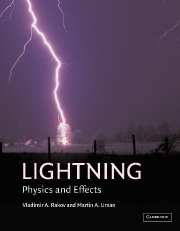Book contents
- Frontmatter
- Contents
- Preface
- 1 Introduction
- 2 Incidence of lightning
- 3 Electrical structure of lightning-producing clouds
- 4 Downward negative lightning discharges to ground
- 5 Positive and bipolar lightning discharges to ground
- 6 Upward lightning initiated by ground-based objects
- 7 Artificial initiation (triggering) of lightning by ground-based activity
- 8 Winter lightning in Japan
- 9 Cloud discharges
- 10 Lightning and airborne vehicles
- 11 Thunder
- 12 Modeling of lightning processes
- 13 The distant lightning electromagnetic environment: atmospherics, Schumann resonances, and whistlers
- 14 Lightning effects in the middle and upper atmosphere
- 15 Lightning effects on the chemistry of the atmosphere
- 16 Extraterrestrial lightning
- 17 Lightning locating systems
- 18 Deleterious effects of lightning and protective techniques
- 19 Lightning hazards to humans and animals
- 20 Ball lightning, bead lightning, and other unusual discharges
- Appendix: Books on lightning and related subjects
- Index
7 - Artificial initiation (triggering) of lightning by ground-based activity
Published online by Cambridge University Press: 05 June 2013
- Frontmatter
- Contents
- Preface
- 1 Introduction
- 2 Incidence of lightning
- 3 Electrical structure of lightning-producing clouds
- 4 Downward negative lightning discharges to ground
- 5 Positive and bipolar lightning discharges to ground
- 6 Upward lightning initiated by ground-based objects
- 7 Artificial initiation (triggering) of lightning by ground-based activity
- 8 Winter lightning in Japan
- 9 Cloud discharges
- 10 Lightning and airborne vehicles
- 11 Thunder
- 12 Modeling of lightning processes
- 13 The distant lightning electromagnetic environment: atmospherics, Schumann resonances, and whistlers
- 14 Lightning effects in the middle and upper atmosphere
- 15 Lightning effects on the chemistry of the atmosphere
- 16 Extraterrestrial lightning
- 17 Lightning locating systems
- 18 Deleterious effects of lightning and protective techniques
- 19 Lightning hazards to humans and animals
- 20 Ball lightning, bead lightning, and other unusual discharges
- Appendix: Books on lightning and related subjects
- Index
Summary
Triggering lightning at will, at a predetermined place and time, is the old Promethean dream which seems related more to legend than to science.
P. Hubert (1984)Introduction
This chapter is concerned primarily with the artificial initiation (triggering) of lightning discharges from natural thunderclouds by means of the “rocket-and-wire” technique. This technique involves the launching of a small rocket that extends a thin wire (either grounded or ungrounded) into the gap between the ground and a charged cloud overhead. Additionally, other types of ground-based activity used to trigger lightning will be briefly reviewed. We limit the use of the term “triggered lightning” to those discharges intentionally stimulated to occur by ground-based activity, the energy source being a naturally electrified cloud. Laboratory discharges between metallic electrodes, which are often used to simulate lightning effects and whose length can reach some tens and even hundreds of meters (e.g., Anisimov et al. 1988; Mrazek 1998) and discharges of up to 3 m length produced using artificially charged aerosol clouds (e.g., Vereshchagin et al. 1989, 1996; Antsupov et al. 1990, 1991) draw their energy from man-made sources and therefore are not considered here. Upward lightning discharges between a stationary, ground-based object (usually of large height) and a naturally electrified cloud, which are sometimes (e.g., Pierce 1974) referred to as triggered lightning, are considered in Chapter 6.
- Type
- Chapter
- Information
- LightningPhysics and Effects, pp. 265 - 307Publisher: Cambridge University PressPrint publication year: 2003
- 4
- Cited by



